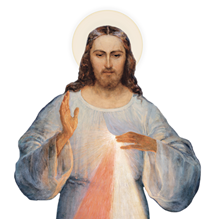
Parts of Poland still feel that way. Our group's tour guide at Auschwitz gestured to the grass and flowers at our feet and told us, "Everything is growing on the ashes [of the victims]. We're walking on the ashes."
As Christians, we know that life springs from death, that holy beauty exists beside hellish evil, and that God's ways don't always match human expectations. Six years before Hitler invaded Poland, St. Faustina offered a special prayer on the day of her perpetual vows: "Jesus, I beg You for my homeland; protect it against the assaults of its enemies" (Diary of St. Faustina, 119). To the world, it might seem as though this prayer failed. Poland was conquered, fractured, and terrorized: desecrated by the Nazis and then swallowed up by the Communists.
And yet, Jesus promised St. Faustina, "I bear a special love for Poland, and if she will be obedient to My will, I will exalt her in might and holiness. From her will come forth the spark that will prepare the world for My final coming" (Diary, 1732). "The land of death" would become the birthplace of the modern Divine Mercy devotion.
Poland is now politically free, and God has honored her by lighting on her soil the "spark" through His revelations to St. Faustina. Saint Faustina's prayer that her motherland be protected "against the assault of its enemies," however, is still very necessary. Jesus warned, "Do not fear those who kill the body but cannot kill the soul; rather fear him who can destroy both body and soul in hell" (Mt 10:28).
Poland isn't alone in needing this warning. Most modern nations seem more afraid of being destroyed by other countries than of disobeying God.
In the shrine at Czestochowa, upstairs from the famous icon of the Black Madonna, a 21st-century Way of the Cross reminds us that our real enemy is not the evil outside of us but the sin within us. In March 2001, the late Polish painter Jerzy Duda Gracz presented the monastery at Jasna Gora, one of the most popular pilgrimage sites in the world, with new Stations of the Cross. Gracz named these paintings after Golgotha, the mountain where Jesus was crucified, but many of the landscapes and faces he included in them are eerily recognizable to present-day viewers.
In painting the Stations, Gracz wanted to show contemporary Christians that Jesus' Passion is not a long-ago event committed in a distant land by distant people. Rather, it is the blow we strike at the exposed Sacred Heart every time we reject Christ's offer of love: in other words, every time we sin. Gracz said, "This Golgotha is present today, now and here, in the Catholic Poland."
It is not only in Poland. The sins Gracz depicts are those of the entire western world. In the first station, entitled "Pilate," microphones and lights crop up from the crowds around Jesus, and beside Pilate's basin of water stands a Catholic cardinal with a blindfold over his eyes. When Jesus falls for the second time, He is ignored by a crowd too busy preparing for Easter to notice His suffering. After His third fall, He lies near the bodies of aborted babies and weeps at the feet of children who are being used as soldiers and prostitutes.
But there are also reminders that healing is possible when we accept the graces God holds out for us. Jesus meets His mother because a throng of women lift Marian images above their heads. Station VI shows Mother Teresa as Veronica, and in Station X, when Jesus is stripped of His garments, He is sheltered by a canopy in a First Communion procession, where little girls throw flowers on His path.
At the crucifixion, the Blessed Virgin and St. John are represented by the icon of Our Lady of Czestochowa and Pope John Paul II, but dozens of other holy faces also flank the Lord's cross. Among them, toward the back, almost invisible in the shadows because of her dark habit, is St. Faustina.
O. Jan Golonka, OSPPE, called Christ's Passion "a mirror of Divine Mercy, in which every generation can look into its own individual and collective sins. This mirror shows the truth about the man and the nation." In this mirror we learn that while the sins of others can kill our bodies, only our own sins can kill our souls. Political enemies scarred Poland's landscape and memory, but she has the Lord's word that He will not only protect her as St. Faustina asked, but also that He will "exalt her in might and holiness" if she turns from sin and obeys His will. Let us "go and do likewise" (Luke 10:37).
For the sake of His sorrowful Passion, have mercy on us and on the whole world.
Marian Tascio is a writer and English teacher who lives in Yonkers, N.Y.

















